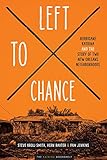Left to Chance : Hurricane Katrina and the Story of Two New Orleans Neighborhoods / Vern Baxter, Steve Kroll-Smith, Pam Jenkins.
Material type: TextSeries: The Katrina BookshelfPublisher: Austin : University of Texas Press, [2021]Copyright date: ©2015Description: 1 online resource (180 p.)Content type:
TextSeries: The Katrina BookshelfPublisher: Austin : University of Texas Press, [2021]Copyright date: ©2015Description: 1 online resource (180 p.)Content type: - 9781477303856
- 976.3/35064 23
- online - DeGruyter
| Item type | Current library | Call number | URL | Status | Notes | Barcode | |
|---|---|---|---|---|---|---|---|
 eBook
eBook
|
Biblioteca "Angelicum" Pont. Univ. S.Tommaso d'Aquino Nuvola online | online - DeGruyter (Browse shelf(Opens below)) | Online access | Not for loan (Accesso limitato) | Accesso per gli utenti autorizzati / Access for authorized users | (dgr)9781477303856 |
Frontmatter -- CONTENTS -- Acknowledgments -- Foreword -- Prologue -- Introduction: Water, Conversations, and Race -- I: NAVIGATING CONTINGENCY IN TWO HISTORIC NEIGHBORHOODS -- 1. “Katrina Takes Aim” -- 2. Geographies of Class and Color -- II: FROM EVACUEES TO EXILES -- 3. Life on the Road -- 4. From the Road to Exile -- III: TRAVERSING AND REBUILDING -- 5. It’s Available, but Is It Accessible? -- 6. Rebuilding in a Broken City -- 7. “The Katrina Effect” -- Epilogue: Making a Space for Chance -- Notes -- About the Authors and Series Editor -- Index
restricted access online access with authorization star
http://purl.org/coar/access_right/c_16ec
How do survivors recover from the worst urban flood in American history, a disaster that destroyed nearly the entire physical landscape of a city, as well as the mental and emotional maps that people use to navigate their everyday lives? This question has haunted the survivors of Hurricane Katrina and informed the response to the subsequent flooding of New Orleans across many years. Left to Chance takes us into two African American neighborhoods—working-class Hollygrove and middle-class Pontchartrain Park—to learn how their residents have experienced “Miss Katrina” and the long road back to normal life. The authors spent several years gathering firsthand accounts of the flooding, the rushed evacuations that turned into weeks- and months-long exile, and the often confusing and exhausting process of rebuilding damaged homes in a city whose local government had all but failed. As the residents’ stories make vividly clear, government and social science concepts such as “disaster management,” “restoring normality,” and “recovery” have little meaning for people whose worlds were washed away in the flood. For the neighbors in Hollygrove and Pontchartrain Park, life in the aftermath of Katrina has been a passage from all that was familiar and routine to an ominous world filled with raw existential uncertainty. Recovery and rebuilding become processes imbued with mysteries, accidental encounters, and hasty adaptations, while victories and defeats are left to chance.
Mode of access: Internet via World Wide Web.
In English.
Description based on online resource; title from PDF title page (publisher's Web site, viewed 26. Apr 2022)


